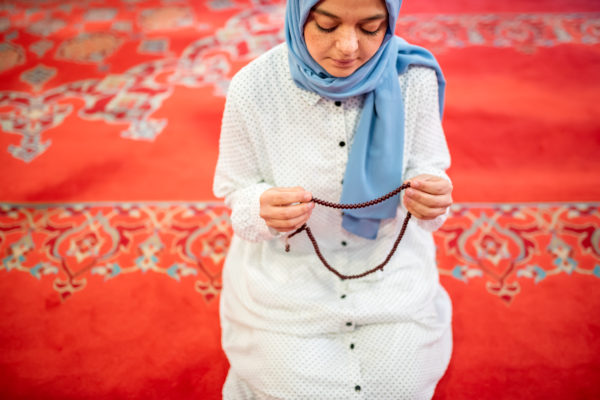There is strong evidence to support that tears and weeping are not merely weaknesses that humans exhibit, rather they are the means by which we gain strength to live this transitory life on earth.
There is strong evidence to support that tears and weeping are not merely weaknesses that humans exhibit, rather they are the means by which we gain strength to live this transitory life on earth.
Throughout human history tears and weeping have been natural parts of our collective experience. As Islam is commonly described to be a Deen al Fitra, a religion based on intrinsic nature and original disposition, it would be expected that the shedding of tears and weeping is not only widely accepted but even encouraged by the Islamic perspective.
However, recent ideas have questioned this concept of weeping and lamenting, particularly in public and over deceased loved ones. It seems that tears have an incredible impact on both the weeper and the observer in Islam. Tears and weeping highlight both our strengths and weaknesses, a constant dash between fear and hope.
In this article we seek to understand, what are our tears in the eyes of God? Are our tears a sign of strength in our faith or are they a symbol of weakness when overcome by fear and helplessness?
Weeping In Quran and Hadith Narrations
The Holy Quran itself does mention crying or weeping, albeit mainly in the form of prayer or a deep recognition of faith as it is strikingly described in one of the earlier surahs, “And when they listen to the revelation received by the Messenger, thou wilt see their eyes overflowing with tears, for they recognize the truth: they pray: “Our Lord! we believe; write us down among the witnesses” ( Al Quran, 5:83).
There is also a chain of prophethood that begins with Adam and ends with Muhammad where we can gather from the many exegeses of the Quran and hadith narrations that almost all of the often-mentioned prophets, at one time or another, wept.
Adam, with his dejection from heaven, Noah and Moses fearing for the outcome of their people, and most notably Jacob who cried endlessly for his beloved son Joseph when he was separated from his family and was thought to be deceased.
The Quran describes it as well, when Jacob, “turned away from them, and said: “How great is my grief for Joseph!” And his eyes became white with sorrow, and he fell into silent melancholy” (Al- Quran, 12:84, Yusuf Ali English Translation). Many scholars agree that his eyes were blinded by excessive crying and when his sons questioned this constant grief, he turned to silent mourning that only ended with his long-awaited reunion with Joseph.
The seal of prophets in Islam, Muhammad, was not one to shy away from weeping either. In fact, in the early days of prophethood, there was an entire year named the Year of Sorrow (Aam al Huzn) in which both his guardian and uncle, Abu Talib, and beloved wife Khadija passed away.
There are narrations of Muhammad weeping at the passing of his infant son, Ibrahim, and at the graves of his friends and family, as one hadith recounts, “We were with God’s Messenger at a funeral. He sat at the edge of the grave and wept until the earth became wet. Then he said, ‘My brothers, prepare for the likes of this!’ (Ibn Maja, Zuhd 19).
When attacked viscously by members of the Meccan community during this early mission period, his daughter would weep while cleaning up the defecations that were thrown his way. Instead of putting an end to the crying, he consoled her and promised that God would protect him from his enemies.
In another instance, shortly before his death, his daughter Fatima is told a prophecy that makes her weep. When asked later what it was that made her cry, she explains she was told “that he will be leaving this world soon, for that I wept. Then he immediately told me that I will be the first of my family to join him in paradise, for that I smiled” (Bukhari, Volume 4, Book 56).
It is significant to point out here that it is consolation that is given to the weeper instead of condemnation, regardless of the circumstance, whether the Prophet himself grieved or if others wept in his presence. Despite evidence that Muhammad most likely never disapproved of weeping over the losses of loved ones or the general tribulations of this world, the general consensus among mainstream Muslims today is not to weep excessively.
This can be partly due to the practice of ostentatious weeping by the pre-Islamic community, a time often called the Age of Ignorance. Another reason why weeping would be discouraged is that it can be considered a sign of disbelief (kufr) in the decree of God and his divine mercy. While this may be true in some schools of thought, it would be a futile attempt to stop a natural phenomenon, one that even the Prophet himself, often called the ‘mercy to mankind’, couldn’t help from practicing.
Conversely, the Quran mentions a particular event in relation to weeping, when the pharaoh’s army lay drowning in the Red Sea, “and the heaven and earth wept not for them, nor were they reprieved” (Al- Quran, 44:29, Pickthall). It is understandable that the heavens and earth, and all that was created in it, did not weep for the enemies of God and his messengers, however, would this indicate that they do in fact weep for his messengers and faithful believers?
Weeping on the Death of Prophet Muhammad
As the news of Muhammad’s demise in 630 AD permeated through the city of Medina, it resulted naturally in the time-honored sounds of mourning. Weeping and wailing were heard throughout the oasis, as Hazelton describes vividly in her book After the Prophet, both “men and women, old and young, everyone took up the wail, and surrendered themselves to it” (Hazleton, Lesley, 57).
Even the stalwart companion, Omar, couldn’t help himself as he thrashed about in denial, how could the Messenger of God be dead? The image of the towering warrior in such a state of grief sent a panic into the hearts of the Muslims. Sensing impending chaos, the soon-to-be caliph Abu Bakr and respected elder, took the matter into his own hands and calmly declared the famous lines, “If you worshipped Muhammad, know that he is dead. If you worship God, he is ever-living, immortal” (Hazleton, 58).
The bitter realization of mortality had begun to sink in in the few days since the Prophet’s death, however, there was one member of his family that never ceased to mourn the last Messenger of God, as it was her very own father. With the previous knowledge already granted to her, that she would be the first to join him after his passing, Fatima lived her last days in a complete state of mourning.
Her grief is believed to be twofold, one over the death of her beloved father, and the other being the treatment and abandonment of his immediate family by some members of the community, specifically of her husband Ali, who had been at the Prophet’s side from the beginning of revelation until the very end. So obvious was her weeping that it was perceived as an inconvenience to her neighbors, a scene best described by the scholar Sheikh Qummi in his book House of Sorrows (Qummi, Bayt Al Ahzan/House of Sorrows, Ch. 4):
“A group of the elders of Madinah came to [her husband] ‘Ali and said, “Fatimah weeps day and night! We cannot sleep at night due to it and we cannot find respite during the day. We want you to tell Fatimah that either weep at night and remain silent during the day, or weep during the day and remain silent at night.” Imam ‘Ali replied, “I shall convey your message to her with due respect.”
‘Ali came to Fatimah and saw her engrossed in immense sorrow and when her sight fell upon him, she became calm. ‘Ali said, “The elders of Madinah have requested me to ask you to either weep at night or during the day.”
Fatimah replied, “O Abul Hasan! My life among these people is very short, and soon I will be departing. By Allah! I shall weep constantly until I unite with my father the Prophet of Allah.”
Imam ‘Ali said, “You are at liberty, you may do as you wish.”
Imam ‘Ali then built a house for Fatimah at the cemetery of al-Baqi’, far away from the houses of the people and he named it ‘Baytul Ahzan’ (The House of Sorrows). Every day, Fatimah would proceed towards it weeping. Then she would pray, and weep among the graves, and when night would fall, Imam ‘Ali would come and take her back home.”
There is a remarkable difference between the stoic announcement of the first caliph, Abu Bakr, and that of Ali, who not only allows the almost persistent weeping, but builds a shed near the cemetery in order for his wife to weep comfortably.
These reactions to the death of Muhammad, while both appropriate given their time and circumstance, would pave the way for how weeping and lamenting are viewed in the two major sects of Islam, Sunnis who take Abu Bakr as the first caliph and Shias who would not leave Ali’s side, or him without a title. They would go on to give him a generous one, not only Imam but the first Commander of the Faithful.
Weeping in Shia Islam
When discussing weeping in Islam, a prevalent school of thought that is incorporated in what is today called ‘Shia Islam’, cannot be disregarded. With all mentions of Shi’ism, it is best initiated with the mention of Ahlul Bayt, or literally People of the House of Prophethood.
Although it does include wives, Shiism asserts that the holy household more significantly consists of the Prophet and his immediate family members, namely Fatima, Ali, and their two sons Hasan and Husain, an undeniable bloodline that gave way to his progeny.
Both the Quran and ahadith point to a “thorough purification” (Tirmidhi, Volume 5 Book 44, 3205) of the Ahlul Bayt making them virtually infallible and therefore the rightly guided leaders according to the Shia perspective. According to this belief, the eventual disagreements between ruling caliphs at the time and the Imams of the Shias were not easily forgotten.
This rift cemented the difference even further when Husain finally took a stand and refused to pledge allegiance to the tyrant, Yazid I, who was loathed and feared by the majority. Seeking reform, not power, Husain decided to set out for Kufa from where he had received thousands of letters detailing the corrupt policies of their ruling parties and insisting on him, as the last remaining grandson of the Prophet, to leave the peaceful sanctuary of Medina and come to the capital cities to see the situation for himself.
One can hardly call what ensued a battle, with less than a hundred men with Husain and the opposing army numbering in the thousands, the famous Battle of Karbala could as well be considered a massacre. Attempting to finish off the men of the Ahlul Bayt and hoping to end any valid claim to the caliphate, the opposing army of Yazid was quick to end the lives of these revered men and place their heads on spears to send a clear message: no one could oppose the ruling caliphs without paying a price.
The remaining family, which now mostly consisted of women and children, were camped nearby in the desolate plains of a town aptly named Karbala, a place of “trial and tribulation”. Thinking they had defeated the Prophet’s family from ever claiming a position of power again, Yazid’s army took them as captives and, as was the custom, had them walk in chains into the capital cities of Kufa and Damascus.
Outnumbered and without a single weapon, little did they know that the Ahlul Bayt carried what proved to be the most powerful weapon within them, they were carrying a story that was yet to be told and perhaps more importantly, unshed tears.
What happened post-Karbala is as important as the battle itself, as it highlights the significance of recounting and properly grieving without being limited by time or space. When finally released by the caliphate, some say after forty days and others an entire year later, the holy family is asked if they need anything before their departure to Medina.
Not requesting any goods or mounts, they ask for something that is perhaps unheard of, they request, “Firstly we would like to lament upon Al-Husayn. [They] vacated the rooms and the houses in Damascus, and there did not remain any Hashemite nor a Qurayshi except and she wore black for Al-Husayn, and they mourned, based upon what is transmitted, for seven days” (Majlisi, Bihar ul Anwar, Vol. 45, 279).
It is imperative to point out that what remained of the men in the Ahlul Bayt at this point is one frail son who managed to survive due to illness and that it was a woman, Husain’s sister Zaynab, who was instrumental in leading the family out of captivity and as above accounts relate, the setting up of mourning and lamentation gatherings, now popularly called majlis.
In a time when news traveled slowly, by word of mouth, these majalis would go on to become a permanent fixture in the Shia sphere of faith. What started off as a humble mourning gathering is now a burgeoning event in which people scurry over each other to take a seat on the floor, a consecrated place where heart-wrenching stories of the holy household are recounted, where men, women, and children discover they have a safe place to sit and weep.
There are no limits to the tears here as well, as is related by many scholars, “for everything there is weighing and measuring except tears. A few drops of tears can extinguish oceans of fire” (Kulayni, Usul al Kafi, Vol.1, 15). Tears are evidently powerful in this space and have even posed an apparent threat to rulers for centuries.
More recently, the government of the Ba’athists in Iraq had all but outlawed public lamentation for decades, forcing many to gather in private. There was something about these processions, tears, and slogans that emanated a call to liberty, for a freedom to not only wail but to live to your full potential. With the US invasion and eventual ousting of Saddam’s government in 2003, that freedom was returned, and both the rituals and spontaneous forms of lamenting were made public, attracting millions of weepers from around the world.
We read earlier that the heavens and the earth wept not for the wrongdoers, but as we learn more about the holy household and Husain there seems to be more clarity in who joins us in lamenting, specifically with regards to angels. It would seem we are not alone in our weeping, there is some evidence that angels do weep and are described as sorrowful at the demise of Husain before reaching the earth with his assistance. In Kulayni’s compilation it is described as such (Kulayni, Vol.1, 247):
“The angels said, ‘Lord, You granted us permission to descend and to help him [Husain]. We descended [to earth] but You had already taken his soul away. Allah then sent them inspiration that said, ‘Remain on his grave until you see him come out [Day of Judgement]. Weep for him and for your loss of the opportunity to provide him help and support. You were certainly assigned for his support and to weep for him. The angels then wept in mourning and sadness for their loss of the opportunity to help and support to him.”
The angels wept and, in many accounts, remain weeping at the grave of Husain until the end of days, making the visitation or ziyarat to the shrine of Husain a unique pilgrimage, a journey of love in the presence of angels.
Conclusion
There is strong evidence to support that tears and weeping are not merely weaknesses that humans exhibit, rather they are the means by which we gain strength to live this transitory life on earth. After all, it is God who grants laughter and tears and the Quran further asks us poignantly in the last lines of the same surah, so do you laugh then and not weep? Wasting your time in vanities? ( Al- Quran, 53:43, 60-61)
This verifies that while laughter is a part of life, it is associated with vain desires and temporary pleasures while crying and weeping would correlate to the opposite. Lamenting and shedding tears in the eyes of God is time well-spent in the short life we have, paving the way for an eternal life of contentment.
While weeping and grieving can look like an unraveling to the unaffected observer, it proves time and again that this disengagement from the world is perhaps what we need most to live a full, complete life.
Bibliography
Al-Quran, English translation by Yusuf Ali and Pickthall.
Bukhari, Muhammad ibn Ismail. 1966. Sahih Bukhari. Karachi: Muhammad Sarid.
Hazleton, Lesley. 2010. After the prophet: the epic story of the Shia-Sunni split. New York: Anchor Books
Ibn Mājah, al-Ghani al-Dihlawi and Suyūṭī. 1952. Sunan Ibn Majah. Karachi: Vali Muhammad.
Kulayni, Muhammad ibn Yaqub. 2015. Usul al-Kafi. New York: The Islamic Seminary, Inc.
Majlisī, Muḥammad Bāqir ibn Muḥammad Taqī. 1956. Bihar al-Anwar. Tehran: Javad al-Alavi
Qummi, Sheikh Abbas. 2010. Bayt al Azhan (English Translation: House of Sorrows). IPH.
Tirmidhi, Muḥammad ibn ʻĪsá. 1900. Jami’ al-Tirmidhi. Karachi: Karkhana Tijarat Kutab.





